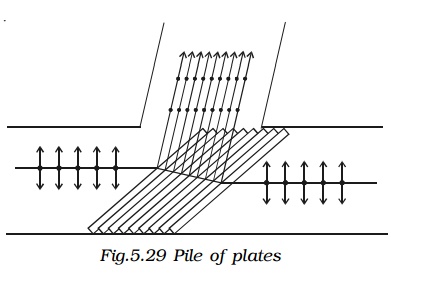Chapter: physics 11th 12th standard school college definition answer assignment examination viva question
Double refraction

Pile of plates
The phenomenon of polarisation by reflection is used in the construction of pile of plates. It consists of a number of glass plates placed one over the other as shown in Fig 5.29 in a tube of suitable size. The plates are inclined at an angle of 32.5o to the axis of the tube. A beam of monochromatic light is allowed to fall on the pile of plates along the axis of the tube. So, the angle of incidence will be 57.5o which is the polarising angle for glass.

The vibrations perpendicular to the plane of incidence are reflected at each surface and those parallel to it are transmitted. The larger the number of surfaces, the greater is the intensity of the reflected plane polarised light. The pile of plates is used as a polariser and an analyser.
Double refraction
Bartholinus discovered that when a ray of unpolarised light is incident on a calcite crystal, two refracted rays are produced. This phenomenon is called double refraction (Fig. 5.30a). Hence, two images of a single object are formed. This phenomenon is exhibited by several other crystals like quartz, mica etc.

When an ink dot on a sheet of paper is viewed through a calcite crystal, two images will be seen (Fig 5.30b). On rotating the crystal, one image remains stationary, while the other rotates around the first. The stationary image is known as the ordinary image (O), produced by the refracted rays which obey the laws of refraction. These rays are known as ordinary rays. The other image is extraordinary image (E), produced by the refracted rays which do not obey the laws of refraction. These rays are known as extraordinary rays.
Inside a double refracting crystal the ordinary ray travels with same velocity in all directions and the extra ordinary ray travels with different velocities along different directions.
A point source inside a refracting crystal produces spherical wavefront corresponding to ordinary ray and elliptical wavefront corresponding to extraordinary ray.
Inside the crystal there is a particular direction in which both the rays travel with same velocity. This direction is called optic axis. The refractive index is same for both rays and there is no double refraction along this direction.
Related Topics